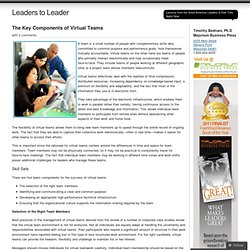

Search Results Extended network team.
Virtuoso teams. Virtual Teams (teams developed and/or operated over the Internet/Web) Note that the reader might best be served to first read the topic Group Dynamics to understand the basic nature of most groups and their typical stages of development.

(It's not clear at this time if online groups have similar nature and stages.) Sections of This Topic Include BasicsManaging and Leading Virtual TeamsA Virtual Team ToolkitAdditional Perspectives on Virtual TeamsFree Services to Provide Online MeetingsFacilitation Library5 Tips for Conducting a Virtual Meeting Also see The following are group-based methods.Action LearningCommitteesCommunities of PracticeConflict ManagementDialoguingFacilitationFocus GroupsGroup CoachingGroup Conflict ManagementGroup Dynamics (about nature of groups, stages of group development, etc)Group LearningGroup-Based Problem Solving and Decision MakingLarge-Scale InterventionsMeeting ManagementOpen Space TechnologySelf-Directed and Self-Managed Work TeamsTeam BuildingTraining and Development Related Library Topics Basics A Virtual Team Toolkit Also see:
Global teams- virtual teams. How teams work: 2 Types of virtual team. Several ways of characterising or classifying virtual teams have been proposed in the literature. One of the most popular was elaborated by Fisher and Fisher (2001), who argued that virtual teams typically can be characterised by three variables, or dimensions. These variables are time, space and culture, although other authors also refer to the third variable as organisation. Thinking about these three variables as dimensions enables us to draw the diagram shown in Figure 2.
(Adapted from Kimble et al., 2000) Figure 2 The space, time and culture classification of virtual teams Understanding these three variables is useful in determining what kind of virtual team you might be involved in and in helping you decide on appropriate actions to improve them. Time refers to when people work. Space (or place) refers to where people work. Culture (or organisation) refers to who people work for and how people work together. Activity 2. How Successful Virtual Teams Collaborate - Keith Ferrazzi. By Keith Ferrazzi | 12:00 PM October 24, 2012 I have worked on many teams in which we dutifully did our jobs, and the group fulfilled its objectives.

And then I have worked on other teams in which everyone energetically collaborated with one another, and the results were spectacular. Not only did we surpass our goals, we also thoroughly enjoyed and benefited from that process as individuals. In other words, there’s a world of difference between merely working together and truly collaborating with one another.
Collaborative activity is the “secret sauce” that enables teams to come up with innovative new products or creative, buzz-worthy marketing campaigns. Achieving true collaboration — in which the whole is definitely more than the mere sum of the individual parts — is difficult in any environment. Adjust for size. Don’t be afraid of social media. Play games. Train for collaboration. Have role clarity but task uncertainty. Virtual Collaboration: The Skills Needed to Collaborate in a Virtual Environment. Keywords: Virtual collaboration, virtual collaboration skills, virtual collaboration barriers.

Introduction Virtual Collaboration Teams (VCTs), generally defined, are groups of individuals, geographically dispersed, that work together using collaborative technology (e.g. chat rooms, e-mail, instant messaging, video conferencing, etc.) in order to accomplish organizational goals (Brake, 2006; Cottone, Pieti, Schiavinato, Soru, Martinelli, Varotto, & Mantovani, 2009; Fruchter, Bosch-Sijtsema, & Ruohomaki, 2010; Suduc, Bizoi, & Filip, 2009; and Zhang, Tremaine, Egan, Milewski, O’Sullivan, & Fjermestad, 2009). Many organizations use VCTs because they are inexpensive, independent of time and space, more efficient, more effective, and are better able to share information, than face-to-face teams (Eom, 2009; Muntean, 2009; Suduc, Bizoi, & Filip, 2009; and Zhang et al., 2009).
Relationship Building Skills Trust Familiarity. Anywhere worker. Virtual teams really are different: 6 lessons for creating successful ones. Consider this:The office of the future might not be an office at all.

As virtual teams become more prevalent, we edge ever closer to a culture where "work" means logging in to your company's online project management site from your home or collaborating with people who each work for different teams or functions at their local co-working establishment. "Company headquarters" is becoming more of a concept than an actual building. And as physical location becomes less important, companies can hire the best talent regardless of their location. In addition, companies can enhance their efficiency by handing off work across time zones, enabling them to be productive around the clock. But far too often, say Darleen DeRosa and Rick Lepsinger, this vision of the global economy workplace falls short of today's reality.
Unfortunately, explain the authors, having solid business reasons for implementing a virtual strategy does not mean that strategy is always going to be executed well. The Key Components of Virtual Teams. A team is a small number of people with complementary skills who, committed to common purpose and performance goals, hold themselves mutually accountable.

Virtual teams on the other hand are teams of people who primarily interact electronically and may occasionally meet face-to-face. They include teams of people working at different geographic sites or a project team whose members telecommute. Virtual teams effectively deal with the realities of time compression, distributed resources, increasing dependency on knowledge-based input, a premium on flexibility and adaptability, and the fact that most of the information they use is in electronic form. They take advantage of the electronic infrastructure, which enables them to work in parallel rather than serially, having continuous access to the latest and best knowledge and information.
This allows individual team members to participate from remote sites without abandoning other aspects of their work and home lives. Skill Sets People Purpose.
Action teams and engagement. Teams versus groups. Comparing groups and teams. Communities of practice.